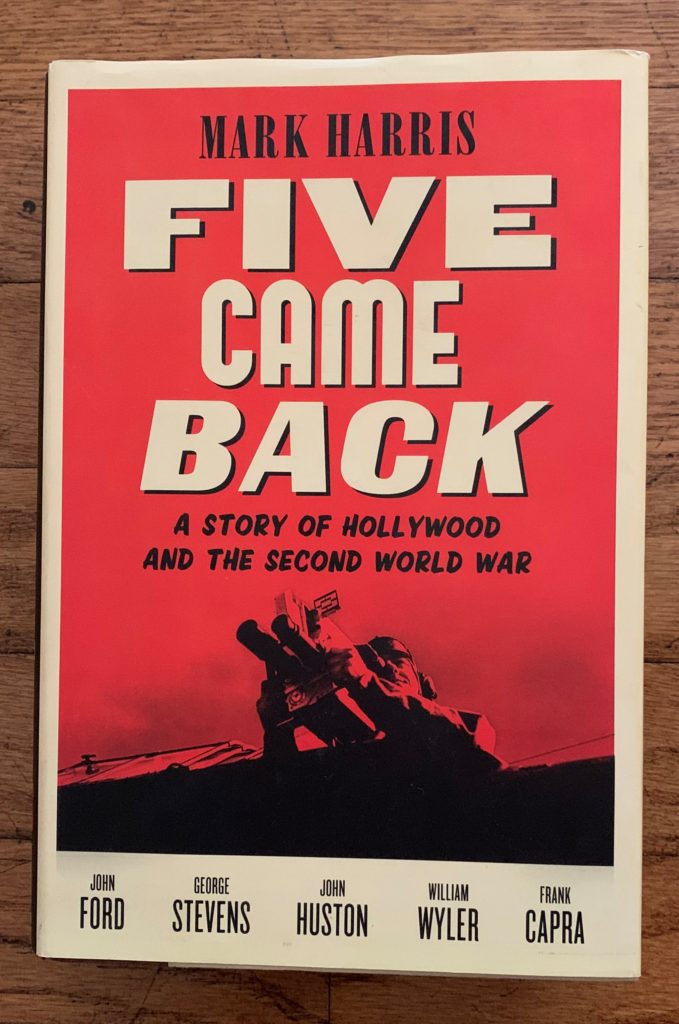
Five Came Back (A Story of Hollywood and the Second World War) by Mark Harris is a remarkable book about Hollywood’s role in WWII and the five legendary directors who chose to go, and come back: John Ford (Stagecoach, The Grapes of Wrath, The Searchers), George Stevens (A Place in the Sun, Giant, Shane), John Huston (The Maltese Falcon, The Treasure of the Sierra Madre, The African Queen), William Wyler (Mrs. Miniver, The Best Years of Our Lives, Roman Holiday), and Frank Capra (It’s a Wonderful Life, It Happened One Night, Mr. Smith Goes to Washington). The book explores the unprecedented move of the U.S. government to farm out its war propaganda effort to Hollywood and allow the directors to film in combat zones. They were on the scene at most major events of the war and shaped the public collective consciousness. The directors felt compelled to film the real war – the patriotic and the horrific.
I recently discovered that Netflix made a limited series (3 one-hour episodes) documentary based on the book in 2017. The series is a wonderful account of their journeys and contains the true footage of unfolding warfare through the eyes of these storytellers: Steven Spielberg (Wyler), Francis Ford Coppola (Huston), Paul Greengrass (Ford), Lawrence Kasdan (Stevens), and Guillermo del Toro (Capra) each discuss the legacies of one of the directors with Meryl Streep providing the narration.
In the 1940s, one-half of the American population were regulars at the movie theater. And every movie started with the newsreels providing an update on the war. The attack on Pearl Harbor shocked the nation and transformed the country’s war message. Film was seen as the medium to inspire the troops and the public to support the war effort. There were no scripts for this. The directors were to make documentaries and bring the war home to people like never before. Ford’s The Battle of Midway showed in no uncertain terms that Hollywood was no longer making it up. Midway was an inspiring American victory that hammered home the reality of war. Americans had never seen a real kamikaze pilot dive-bomb an aircraft carrier. In Why We Fight, Capra counterattacked the Nazis by using their own propaganda against them by showing America the evil they were up against. For Memphis Belle, Wyler went on air missions and caught some of the most extraordinary footage of the war, including a B-17 spiraling down with airmen bailing out with parachutes. (Wyler would later suffer permanent, significant hearing damage from filming inside the noisy B-25s.) Ford and Stevens used hundreds of cameras and dozens of men to film the invasion on D-Day. (Most of the footage was lost at sea; what came back – produced by Capra – could not be shown to the public because it contained “too much carnage.”) Ford and Stevens were there when the world discovered the atrocities of the concentration camps. Their films from Dachau were the first holocaust footage seen around the world. The films would be shown as evidence in the war crime trials at Nuremberg.
Hollywood went back to its crowd-pleasing traditions after the war. That seemed disingenuous to the five directors who would forever be affected by their military service. Frank Capra returned in 1946 with It’s a Wonderful Life. Did you know that it was a big flop, commercially and critically? Of course, for years now, it’s been an annual ritual for millions of families at Christmas time. John Ford went back to Westerns and released one of the best ever, My Darling Clementine. John Huston made the classic The Treasure of the Sierra Madre about searching for gold and personal character along the way (the “stinkin’ badges” movie). George Stevens couldn’t go back to making his beloved comedies and instead came out with dramas like Shane, Giant, and one of my favorite older films, A Place in the Sun. Lastly, William Wyler made the momentous The Best Years of Our Lives about three veterans coming home from the war and their jarring return to life. This was new territory years before PTSD was really acknowledged. I highly recommend this one, one of my all-time favorites (turns out Spielberg has watched this film every year for 30 years.)
I’ll let Mark Harris summarize the life-changing experiences of these directors: “They would go to London and France, to the Pacific theater and the North African front, to ruined Italian cities and German death camps; they would film the war from land, sea, and air in ways that shaped, then and for generations after, America’s perception of what it looked like and sounded like to fight for the fate of the free world. They would honor their country, risk their lives, and create a new visual vocabulary for fictional and factual war movies; some of them would blur the lines between the two, compromising themselves in ways they would spend the rest of their days trying to understand, or justify, or forget. They returned to Hollywood changed forever as men and filmmakers.”
(I can’t close this post without mentioning another excellent Mark Harris book: Pictures at a Revolution: Five Movies and the Birth of the New Hollywood. The book explores the cultural revolution that transformed America and Hollywood through the lens of the five 1967 Best Picture nominations (Bonnie and Clyde, The Graduate, Guess Who’s Coming to Dinner, In the Heat of the Night, and Doctor Doolittle). It will make you want to watch these movies again.
D² Rating (Book and Series) ◼◼◼◼☐
Trivia: Who starred in and won the Academy Award for Best Actor in The Best Years of Our Lives?
Answer: Frederic March